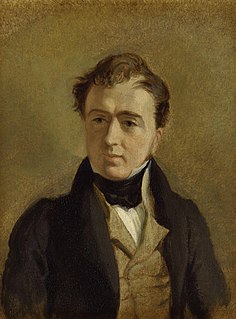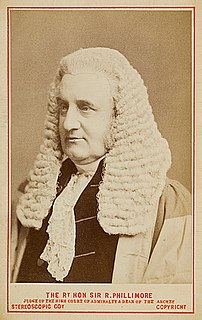
Baron Northbrook, of Stratton in the County of Southampton, is a title in the Peerage of the United Kingdom. It was created in 1866 for the Liberal politician and former Chancellor of the Exchequer, Sir Francis Baring, 3rd Baronet. The holders of the barony represent the genealogically senior branch of the prominent Baring family. The name Northbrook is derived from a tithing of the local parish.

Baron Phillimore, of Shiplake in the County of Oxford, is a title in the Peerage of the United Kingdom. It was created in 1918 for the former Judge of the High Court of Justice and Lord Justice of Appeal, Sir Walter Phillimore, 2nd Baronet. The Phillimore Baronetcy, of The Coppice, had been created in the Baronetage of the United Kingdom on 28 December 1881 for his father Sir Robert Phillimore, who was also a noted lawyer and judge. The first Baron was succeeded by his son, the second Baron.
Baron Moncreiff, of Tulliebole in the County of Kinross, is a title in the Peerage of the United Kingdom. It was created on 9 January 1874 for the lawyer and Liberal politician Sir James Moncreiff, 1st Baronet. He had already been created a Baronet, of Kilduff in the County of Kinross, in the Baronetage of the United Kingdom on 23 May 1871. In 1883 Lord Moncreiff also succeeded his elder brother as 11th Baronet, of Moncreiff in the County of Perth. On his death the titles passed to his eldest son, the second Baron. He was a Judge of the Court of Session from 1888 to 1905 under the title of Lord Wellwood and served as Lord Lieutenant of Kinross-shire between 1901 and 1909. He was succeeded by his younger brother, the third Baron. He was a clergyman. As of 2010 the titles are held by the latter's great-grandson, the sixth Baron, who succeeded his father in 2002.

There have been four baronetcies created for members of the Acland family, which originated in the 12th century at the estate of Acland in the parish of Landkey, North Devon, two in the Baronetage of England and two in the Baronetage of the United Kingdom.
The Stanley, later Stanley-Massey-Stanley, later Errington Baronetcy, of Hooton in the County of Chester, was created in the Baronetage of England on 17 June 1661 for William Stanley, the great-grandson of Sir William Stanley, of Hooton and Stourton, a member of the Stanley family headed by the Earl of Derby. The sixth Baronet assumed the surname Stanley-Massey-Stanley. The ninth Baronet married Mary Haggerston, great-niece and heiress of Henry Errington of Sandhoe House, Northumberland. Their eldest son, the tenth Baronet, represented Pontefract in Parliament. Their second son, Rowland Stanley, the eleventh Baronet, inherited the Errington estate in Northumberland and changed his name and arms to Errington. The title became extinct on the death of the twelfth Baronet in 1893.
Nineteen baronetcies have been created for persons with the surname Hamilton, eight in the Baronetage of Nova Scotia, one in the Baronetage of England, five in the Baronetage of Ireland, one in the Baronetage of Great Britain and four in the Baronetage of the United Kingdom. As of 2008 two creations are extant, two are dormant, two are either extinct or dormant and twelve extinct.

There have been two baronetcies created for members of the Dashwood family, one in the Baronetage of England and one in the Baronetage of Great Britain. Both creations are extant as of 2008.

There have been four baronetcies created for persons with the surname Montgomery, one in the Baronetage of Nova Scotia, one in the Baronetage of Great Britain and two in the Baronetage of the United Kingdom. One creation is extant as of 2011.
There have been two baronetcies created for members of the Blackett family, both in the Baronetage of England. One creation is extant as of 2013. The Blackett family can be traced back to the Blacketts/Blakheveds of Woodcroft, County Durham, some of whom became highly successful in the lead and coal mining industries in Northumberland and County Durham.

There have been four baronetcies created for persons with the surname Rose, all in the Baronetage of the United Kingdom. Three of the creations are extant as of 2010.
There have been three baronetcies created for persons with the surname Kinloch, two in the Baronetage of Nova Scotia and one in the Baronetage of the United Kingdom. Two of the creations are extant as of 2010.
There have been six baronetcies created for persons with the surname of Lawson, two in the Baronetage of England and four in the Baronetage of the United Kingdom. Two creations are extant as of 2010.
There have been three baronetcies created for persons with the surname North, one in the Baronetage of England and two in the Baronetage of the United Kingdom. Two creations are extinct while one is extant. The last creation passed into the North family through marriage.

There have been four baronetcies created for persons with the surname Miller, two in the Baronetage of England, one in the Baronetage of Great Britain and one in the Baronetage of the United Kingdom. Two of the creations are extant as of 2008.
There have been two baronetcies created for persons with the surname Prescott, one in the Baronetage of Great Britain and one in the Baronetage of the United Kingdom.
There have been six baronetcies created for persons with the surname Thomas, three in the Baronetage of England, one in the Baronetage of Great Britain and two in the Baronetage of the United Kingdom. Two of the creations are extant as of 2016.
Peers of the Realm have been associated with Australia since early in its history as a British settlement. Many peers served as governors of the Australian colonies, and in the days when the practice of appointing British governors-general was current, the great majority were peers.

There have been three baronetcies, all in the Baronetage of England, created for members of the family of Mansel, which played a major role in the early re-settlement of the Gower Peninsula, in Glamorgan, Wales. Only one creation is extant as of 2008.
There have been five baronetcies created for members of Clan Ramsay, four in the Baronetage of Nova Scotia and one in the Baronetage of the United Kingdom. The baronetcy in the Baronetage of the United Kingdom is extant as of 2021.

Sir Francis Norie-Miller, 1st Baronet was a British insurance company manager director. He was also a Liberal and later Liberal National politician. Although he was born in England, his chief associations were with Scotland and in particular the city of Perth. In 1936, he was created a Baronet with the title of Norie-Miller of Cleeve in the New Year's Honours List for political and public service in the County of Perth and for his local philanthropy.









